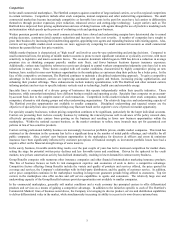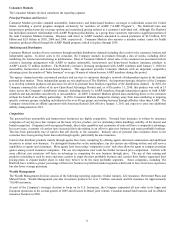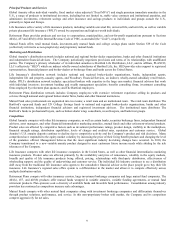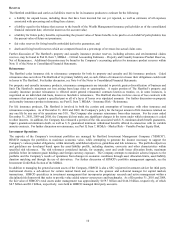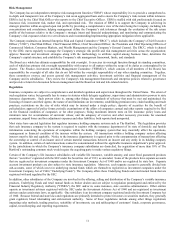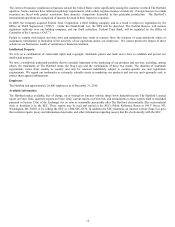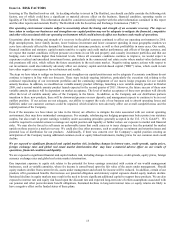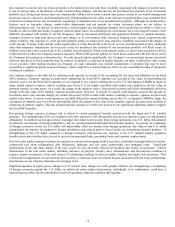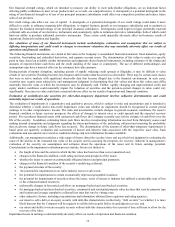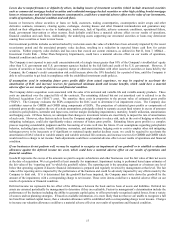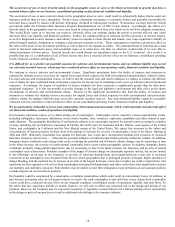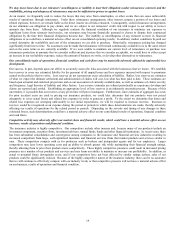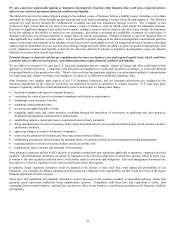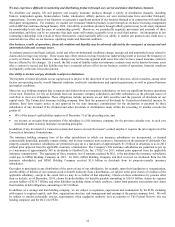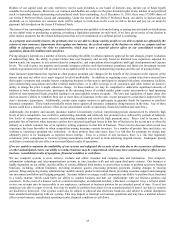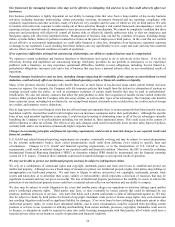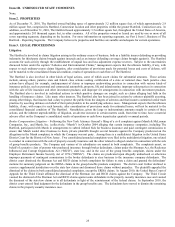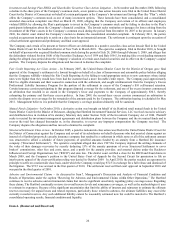The Hartford 2010 Annual Report Download - page 16
Download and view the complete annual report
Please find page 16 of the 2010 The Hartford annual report below. You can navigate through the pages in the report by either clicking on the pages listed below, or by using the keyword search tool below to find specific information within the annual report.
16
Our financial strength ratings, which are intended to measure our ability to meet policyholder obligations, are an important factor
affecting public confidence in most of our products and, as a result, our competitiveness. A downgrade or a potential downgrade in the
rating of our financial strength or of one of our principal insurance subsidiaries could affect our competitive position and reduce future
sales of our products.
Our credit ratings also affect our cost of capital. A downgrade or a potential downgrade of our credit ratings could make it more
difficult or costly to refinance maturing debt obligations, to support business growth at our insurance subsidiaries and to maintain or
improve the financial strength ratings of our principal insurance subsidiaries. Downgrades could begin to trigger potentially material
collateral calls on certain of our derivative instruments and counterparty rights to terminate derivative relationships, both of which could
limit our ability to purchase additional derivative instruments. These events could materially adversely affect our business, results of
operations, financial condition and liquidity.
Our valuations of many of our financial instruments include methodologies, estimations and assumptions that are subject to
differing interpretations and could result in changes to investment valuations that may materially adversely affect our results of
operations and financial condition.
The following financial instruments are carried at fair value in the Company’ s consolidated financial statements: fixed maturities, equity
securities, freestanding and embedded derivatives, and separate account assets. The determination of fair values is made at a specific
point in time, based on available market information and judgments about financial instruments, including estimates of the timing and
amounts of expected future cash flows and the credit standing of the issuer or counterparty. The use of different methodologies and
assumptions may have a material effect on the estimated fair value amounts.
During periods of market disruption, including periods of rapidly widening credit spreads or illiquidity, it may be difficult to value
certain of our securities if trading becomes less frequent and/or market data becomes less observable. There may be certain asset classes
that were in active markets with significant observable data that become illiquid due to the financial environment. In such cases,
securities may require more subjectivity and management judgment in determining their fair values and those fair values may differ
materially from the value at which the investments may be ultimately sold. Further, rapidly changing and unprecedented credit and
equity market conditions could materially impact the valuation of securities and the period-to-period changes in value could vary
significantly. Decreases in value could have a material adverse effect on our results of operations and financial condition.
Evaluation of available-for-sale securities for other-than-temporary impairment involves subjective determinations and could
materially impact our results of operations.
The evaluation of impairments is a quantitative and qualitative process, which is subject to risks and uncertainties and is intended to
determine whether a credit and/or non-credit impairment exists and whether an impairment should be recognized in current period
earnings or in other comprehensive income. The risks and uncertainties include changes in general economic conditions, the issuer’ s
financial condition or future recovery prospects, the effects of changes in interest rates or credit spreads and the expected recovery
period. For securitized financial assets with contractual cash flows, the Company currently uses its best estimate of cash flows over the
life of the security. In addition, estimating future cash flows involves incorporating information received from third-party sources and
making internal assumptions and judgments regarding the future performance of the underlying collateral and assessing the probability
that an adverse change in future cash flows has occurred. The determination of the amount of other-than-temporary impairments is
based upon our quarterly evaluation and assessment of known and inherent risks associated with the respective asset class. Such
evaluations and assessments are revised as conditions change and new information becomes available.
Additionally, our management considers a wide range of factors about the security issuer and uses their best judgment in evaluating the
cause of the decline in the estimated fair value of the security and in assessing the prospects for recovery. Inherent in management’ s
evaluation of the security are assumptions and estimates about the operations of the issuer and its future earnings potential.
Considerations in the impairment evaluation process include, but are not limited to:
• the length of time and the extent to which the fair value has been less than cost or amortized cost;
• changes in the financial condition, credit rating and near-term prospects of the issuer;
• whether the issuer is current on contractually obligated interest and principal payments;
• changes in the financial condition of the security’ s underlying collateral;
• the payment structure of the security;
• the potential for impairments in an entire industry sector or sub-sector;
• the potential for impairments in certain economically depressed geographic locations;
• the potential for impairments of securities where the issuer, series of issuers or industry has suffered a catastrophic type of loss
or has exhausted natural resources;
• unfavorable changes in forecasted cash flows on mortgage-backed and asset-backed securities;
• for mortgage-backed and asset-backed securities, commercial and residential property value declines that vary by property type
and location and average cumulative collateral loss rates that vary by vintage year;
• other subjective factors, including concentrations and information obtained from regulators and rating agencies;
• our intent to sell a debt or an equity security with debt-like characteristics (collectively, “debt security”) or whether it is more
likely than not that the Company will be required to sell the debt security before its anticipated recovery; and
• our intent and ability to retain an equity security without debt-like characteristics for a period of time sufficient to allow for the
recovery of its value.
Impairment losses in earnings could materially adversely affect our results of operation and financial condition.



